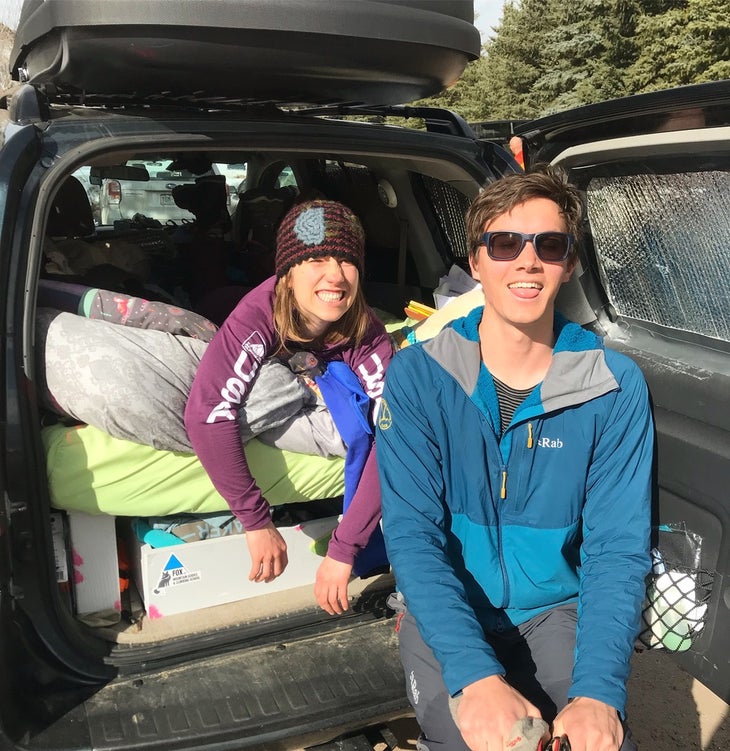How to Date A Mountain Guide
6 min read
Heading out the door? Read this article on the new Outside+ app available now on iOS devices for members!
Download the app.
Originially published in 2020.
The date had gone well, and we were both feeling the chemistry, so he invited me back to his place.
The catch? It was a 2010 Toyota RAV 4.
For a lot of people, dating a mountain guide—someone rugged, windswept, and capable—sounds like a dream. Maybe you have fantasies about hiring a guide and then falling madly in love on an alpine summit after being 3-to-1 hauled through the crux. (From the sound of some client stories, you’re not the only one.) Or maybe, like me, you daydreamed about meeting a talented young climber at the Ouray Ice Festival, falling in love, and traveling the world sending hard alpine routes in perfect harmony.
In 2017, I met my partner in Ouray, all according to plan. We fell for each other and went on our first date about a month later.
That’s when reality and expectations began to diverge. Here are some things I’ve learned.
Step One: Be a Minimalist
The RAV 4 wasn’t a temporary measure; my date had been living in it for about three years.
“It’s pretty cozy,” he offered. This was an understatement. He’s six-foot-six; he basically slept with his feet on the dashboard. I peered inside. It didn’t smell weird, and there were twinkle-lights. I shrugged. We climbed in and opened Netflix.

Guiding in America, like many other romanticized pursuits, comes with the somewhat less romanticized feature of shit pay. You may have heard the classic joke:
What’s the difference between a mountain guide and a large pizza?
A large pizza can feed a family of four.
Some guides make a good living. A lot of them don’t. Right now, I make a good deal more than my partner, even as a journalist. It’s nice to think I’ve suddenly been able to afford a trophy husband, but the reality is that money conversations are always hard, especially with a big salary gap involved. And, of course, it’s hard to travel the world to climb in romantic bliss when you can’t afford plane tickets. So, we’ve adapted. We eat on the cheap. We save our money. And we leave the globe-trotting, power-couple thing to the influencers and the engineers.
Step Two: Sharpen Your Self Confidence
If you’re not careful, the best part about dating a guide—i.e. that they’re always doing cool things and therefore are always a hit at parties—can also become the worst.
I am plagued with bouts of low confidence (what woman in America isn’t?). The first time I went to an event with my boyfriend’s coworkers, I spent the evening white-knuckling my drink, listening to stories about last season’s Everest clients and this season’s big sends, and trying not to feel so small.
Likewise, it’s hard to come home from a crappy day at the office, just wanting complain about Cheryl’s poor email etiquette and Tom’s exhausting last-minute requests, when your partner has just finished explaining how he saved someone’s life via a daring high-angle rescue in a thunderstorm.
It took me a long time to stop comparing my life to his. If you want to date a guide, or anyone chasing a romantic ideal of a life well-lived, first you must know, firmly, that your life is well-lived, too, even though it might look different.
Step Three: Find Other Climbing Partners
After one year of living together in the RAV, my partner and I decided to take the next step and live together in a van. Nearly four years on, life is pretty dreamy. Except for one thing.
When we first starting dating, I thought. This is great. I basically just netted the world’s best belayer. And it’s true. He’s the best belayer, rope gun, and alpine shenanigan-fixer I’ve ever climbed with. There’s no one else I trust more in the mountains.
But, also, that’s his job.
Dating a guide (without being one yourself) usually means that you and your partner share the love of a sport, but that your partner is way better at it than you are. This is fine during the honeymoon phase, but after a couple years, your partner might say something to the effect of:
“Climbing with you feels like work.”
Ouch, right? But it’s not uncommon. If you spent all day analyzing anchors and giving pep talks to scared flatlanders, you’d want to spend your vacation days climbing for yourself, too. Often, my partner comes off a stint of work just dying to move fast on scary 5.12 terrain. To do that, he needs partners who have flawless mountain savvy and a high risk tolerance. (I.e., not me.)
And I’m cool with that. Because when he and I do climb together, I have my own complaints. After all, nothing kills the romantic partnership vibe more than belaying your boyfriend up to your anchor and getting lectured on a cool new knot that literally no one ever uses.
“That anchor is solid. But you could have made it way sleeker. Let me just show you this one thing…”
For date nights these days, we usually stick to pizza and beer. And that’s just fine with us.
Step Four: Be Cool With Constant Mortal Peril
Guiding is an unpredictable profession. During the alpine season, my partner frequently wakes up at 1:00 AM, turns on the lights, and makes breakfast three feet away from me before work. (Did I mention we live in a van?) Sometimes, he comes home four or five hours after I expect him to. When guided days run long, he misses dinner, social events, and dates.
But the hardest part isn’t the early mornings or the late nights. It’s wondering if he’ll come home at all.
About three years ago, the man I dated before my current partner died in a recreational climbing accident. It’s something I’ll never really get over.
Now, my partner’s work and play take him into dangerous terrain year-round. About two years ago, he was hit in the eye by a falling chunk of ice while working. He called me when he got back to the trailhead.
“Will you still love me if I have a giant hole in my face?” he asked quietly.
But he was alive. I drove an hour and a half to the hospital, and cried the whole way.
He ended up with stitches in his cheek and eyebrow, and he had to have his retina surgically reattached. He fully recovered, but I still think about that phone call a lot. And I wonder how long it will be until I have to answer a similar one. Or worse, an accident call where he’s not the one on the other line.
Sometimes I wish my partner would suddenly find a passion for accounting or insurance sales. But the truth is, all the things that make my boyfriend a good guide are the things that make him a good life partner. He’s patient. He’s driven. He’s confident in himself. And he loves the mountains.
I can’t take that away from him. And, despite all the worry, I would never want to.
Step Five: Get Ready to See Climbing Differently
There are always complications when your partner does what they love for work. But the best part of dating a guide is learning to see climbing through the eyes of someone who loves it inside-out, and who keeps loving it despite the long days, the difficult clients, and the constant stress and job insecurity.
Sometimes, we’ll walk together through a field of boulders, and my partner just lights up, incandescent with joy at the lines his imagination draws along every scoop and arête. You can’t be with someone like that and not smile. You can’t spend your life with them and not learn to appreciate the little things—an obscure knot quickly tied, a perfect thumb-catch—so much more. Over time, your perspective changes. It’s a little like falling in love.
Today, I’m a better climber than I was four years ago, but not because my partner and I have been traveling the world, or pushing each other to send, or even climbing together much at all. I’m a better climber because, just by watching him, I’ve learned to love it more.
Our relationship is not the dream I imagined. It’s a different dream. And it’s better.



